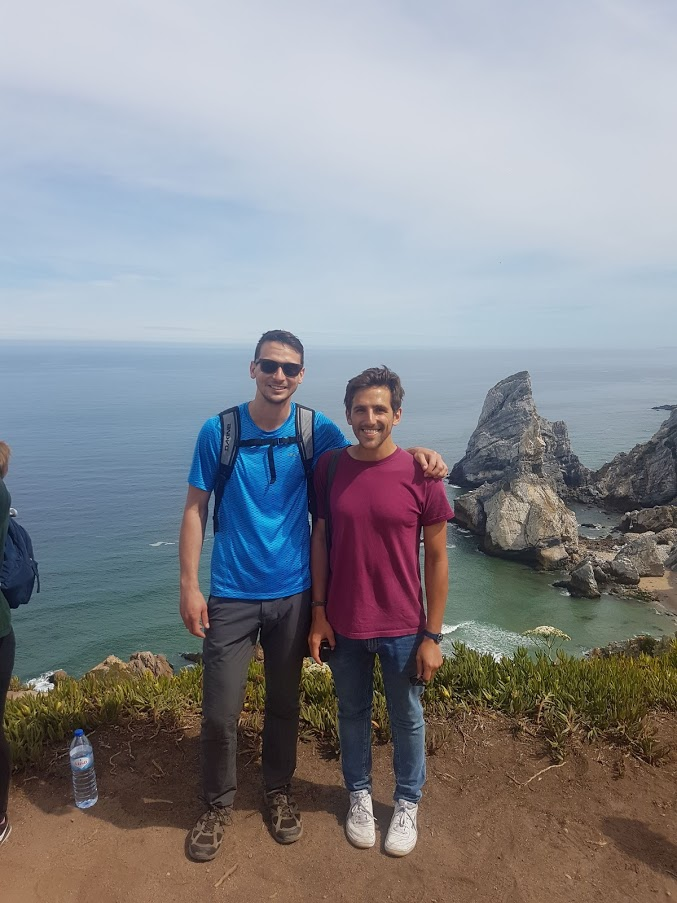I always wanted to experience some time abroad. I lived my whole life in Austria, and after studying for six years in Vienna, I was ready for a change. So, when I heard about the eleven job openings of STACCATO (an European Industrial Doctorate program under the scope of the European Horizon 2020 programme) from a colleague of mine, I thought that this was the perfect opportunity to step out of my comfort zone and try something new. I applied for the ESR (Early Stage Researcher) position 8 hosted at iBET (Instituto de Biologia Experimental e Tecnológica) in Portugal. The topic “Combining single cell RNA sequencing with systems biology to fine-tune the production of recombinant adeno-associated virus vectors (rAAVs)” excited me the most. Moreover, I must admit that the idea of living close to the sea and the nice climate of Portugal were additional benefits to the position itself.
I was very excited when I heard that I was accepted. Even though it was hard for me to say good-bye to all my friends and family, I packed my bags and was eager to start this new chapter in my life.
I used the next couple of days after my arrival to explore Lisbon, some nearby beaches and the neighbourhood around iBET. Even though it wasn’t easy to communicate at first (my Portuguese was limited to two words: bom dia (“Good morning”) and obrigado (“Thank you”), the beauty of Portugal was staggering. I am very glad to be able to call this country home for the next couple of years.
On my first day at iBET, I immediately felt welcomed by all the people of the “Animal Cell Technology Unit”. During this time, I also met my new “partner in crime” Marco Silvano (ESR 7). Marco S. is also conducting his PhD at iBET under the scope of STACCATO and is trying to improve the production of influenza virus-like particles (VLPs) using single cell RNA sequencing. Even though we both have our separate projects, we have several tasks in our PhD where we cooperate or complement each other. I have to say that having someone to share the whole STACCATO experience, the work, travels and ups and downs of a PhD life is very nice.

But before I continue talking too much about my life here in Portugal let’s talk some science…
What are rAAVs, and why do we need them?
Recombinant adeno-associated virus (rAAVs) vectors are promising delivery tools in gene therapy, a procedure in which nucleic acids are delivered directly to patient’s cells to treat or prevent diseases.
Recombinant adeno-associated virus vectors are believed to be specifically suitable for gene therapy applications due to their high transduction efficiency and their good safety profile. Despite the high potential of AAV-based products, gene therapy is still far from being a mainstream clinical practice, mainly due to the high production cost and poor vector quality. The approval of uniQure’s Glybera® in the EU in 2012, the first-ever rAAV based gene therapy product, encouraged other manufacturers in pursuing the development of their own rAAV-based products, leading to increased demand. Nonetheless, current production platforms are not able to fulfil this increased demand in a timely and cost-effective manner, leading to a lack of vectors and resulting in financially painful delays in clinical trials.
What does this have to do with my STACCATO project?
I mentioned that current production platforms are not able to fulfil the current demand of rAAV vectors in a cost-efficient manner. But what are the production platforms currently used?
There are several different platforms available to produce rAAV vectors. The first-ever production was done in adherent HEK293 cells. However, as this system was hard to scale-up, alternative platforms were created such as stable producer cell lines, the herpes simplex virus system and the insect cell baculovirus expression vector system (IC-BEVS). All these platforms have their pros and cons but describing them would exceed the scope of this post. We will focus more on the IC-BEVS system as my work is based on it. However, if you want to read about it in more detail, I recommend a review by Otto-Wilhelm Merten, who wrote a good comparison of the different systems and a nice summary of remaining challenges (Mertens, et al. 2016).
But back to the IC-BEVS…
As adeno-associated virus (AAV) is a small single-stranded DNA virus which depends on the presence of a helper virus for replication, the introduction of helper genes is essential to produce functional virus vectors. The insect cell baculovirus expression vector system is suitable for introducing those helper functions and expressing capsid and replicase genes for successful assembly. Major advantages of the systems are mostly simple scalability and fast production, leading to their popularity as a production platform. Nevertheless, drawbacks of this system still occur, namely low vector titers, quality and potency. Furthermore, the use of the system in a continuous production system is limited due to the lytic effect of the baculovirus.
To tackle those drawbacks and improve the production of rAAVs with IC-BEVS, many scientists try to engineer baculovirus or improve the production process itself. Having said this, we, however, believe that the overall knowledge of the underlying biological mechanisms inside the insect cells should be increased in order to improve production. This leads me to the scope of my project:
Increasing the knowledge of the underlying biological mechanisms of the IC-BEVS
As mentioned before, during my PhD I am going to explore the molecular signatures of insect cells during baculovirus infection using a multi-omics approach. First, I will use single cell RNA sequencing in order to explore the single cell transcriptome and molecular heterogeneity of this cell factory during the infection process. Next, I will supplement this information with bulk metabolomics and fluxomics data, acquired from metabolic flux analysis. Here I will explore changes in flux distributions and nutrient availability throughout the production process. As the last step, I will try to combine the data in a multi-omics approach in order to investigate limiting steps further and deliver metabolic engineering strategies to increase productivity.
Overall, I hope that my PhD will contribute to a better understanding of the insect cell-baculovirus expression vector system and my proposed strategies will allow for an increase in production titers and vector quality in order to make recombinant adeno-associated virus vectors more available.
Concluding this blog post, I would like to summarise my STACCATO experience so far, which was amazing. Next to the outstanding resources STACCATO provides me for my research, I also had the opportunity to spend one week in Dublin to meet our STACCATO coordinator Colin Clarke and to get my first experience in bioinformatics. During this time, I met my fellow ESR’s Alan, Marco R. and Ryan, which showed me around in Dublin. Later we met again during the 1st Annual Industry-Academia Network Training Week in Dublin, where I was also introduced to all the other ESRs for the first time, an amazing group of young scientists.
I would like to encourage everyone to think about pursuing his/her PhD under the scope of a European funded project, and I am looking forward to great years doing my PhD with STACCATO.
Posted by Nikolaus.

